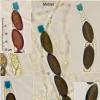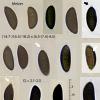
26-10-2025 13:39
Joaquin MartinHi,I found this fungus in a mixed forest of spruce

23-10-2025 20:59
Patrice TANCHAUDBonsoir, est-ce que quelqu'un posséderait un com

24-10-2025 14:50
 Riet van Oosten
Riet van Oosten
Hello, Found by Laurens van der Linde, Oct. 2025

24-10-2025 03:11
 Francois Guay
Francois Guay
I found this fungus growing on decaying conifer wo

20-10-2025 09:36
 Nicolas VAN VOOREN
Nicolas VAN VOOREN
Hello.I'm searching for the following article:Bene

21-10-2025 23:13
F. JAVIER BALDA JAUREGUIHello to everyone.Did you think it could, be a pyx

22-10-2025 14:45
Lukas VerboomDear all,I collected this in the Netherlands, on t
Our common friend P. Zapico has found at his home these gregarious, blackish, roundish, papillate and ostiolate, carbonaceous, perithecia 0.9-1.4 mm in diam. growing over on more or less persistent subiculum on very rotten wood of a cut Salix babylonica.
The asci are cylindrical, 8-spored, 155-170 x 8.5-9 microns, pars sporifera 110-138 with a conspicuous apical apparatus Melzer deep blue 5-6 x 4 micr.
The ascospores are ellipsoid, equilateral, brownish at maturity, with straight germ slit nearly as long as spore, situated on the more convex side, and 1(-2) semiglobose cellular appendage (-s) surrounded by a partial, narrow slimy sheath. (14.7-)16.3(-18.2) x (6.5-)7.0(-8.0); Q = 2.1-2.5
I feel this fungus could be near to Rosellinia akulovii L.E. Petrini but I'd like to know your opinion.
Many thanks in advance for your help

it's good to hear from you and Pedro!
The overall morphology and the ascospores with cellular appendages and germ slit on the convex side clearly set this Rosellinia in the aquila-corticium group. Based on ascospores and apical apparatus dimensions and sheath morphology I would call it R. aquila, even though the ascospores are a bit small. I have seen a wide range of variations in this species, from small-spored collections like yours to large-spored ones grading into R. corticium. They might represent different species but they are difficult to separate based on morphology only.
I do not know R. akulovii for comparison.
Sorry Enrique, I guess you are not going to like my answer!
Cheers,
Jacques
Hi Jacques
No. I like very much your expert opinion on this very difficult genus, at least for me.
Many thanks, Jacques!





